

Real Betis Balompié, SAD, more commonly referred to as Real Betis
or just Betis, is a Spanish football club based in Seville, in the
autonomous community of Andalusia. Founded on 12 September 1907,
it plays in La Liga, having won the Segunda División in the
2014–15 season. It holds home games at Estadio Benito
Villamarín in the south of the city.
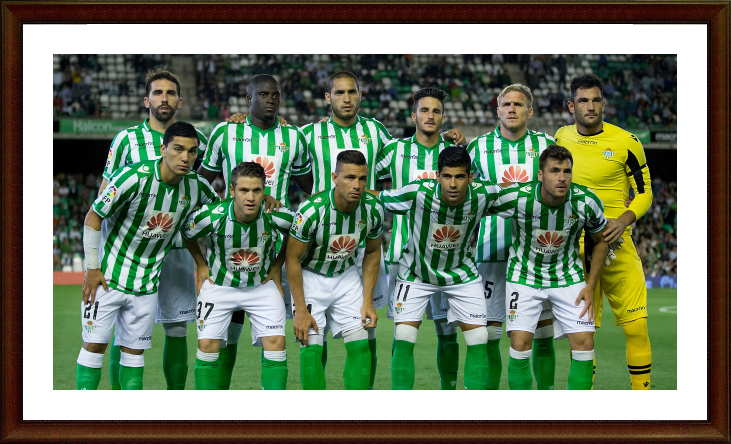
Real Betis won the league title in 1935 and the Copa del Rey in
1977 and 2005. Given the club's tumultuous history and many
relegations, its motto is Viva el Betis manque pierda! ("Long live
Betis even when they lose!").
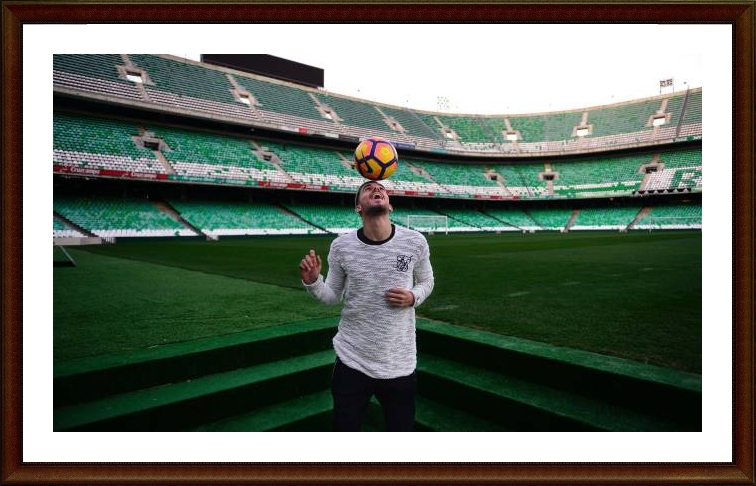
Between 1979 and 1982, the capacity of the stadium was increased
up to 50,253 for the 1982 FIFA World Cup when it hosted 2 group
matches.In July 2016, the southern stand of the stadium was
demolished for expansion. After re-modelisation, the total
capacity of the stadium will increase from 52,000 to 60,720 seats.
The expansion
work was completed in August 2017 in time for the 2017-18 La Liga
Season.
With a 56,500-seat capacity, the Estadio Benito Villamarín is the
home ground of Real Betis. It was named Estadio Manuel Ruiz de
Lopera during the 2000s (decade) after the club's owner, who
decided to build a new stadium over the old one. Despite much
planning, the stadium's renovation plans were constantly
postponed, and half of it remained unchanged. On 27 October 2010,
it returned to its first denomination after a decision
by the club's associates.
The name "Betis" is derived from Baetis, the Roman name for the
Guadalquivir river which passes through Seville. Real was added in
1914 after the club received patronage from King Alfonso
XIII.Betis' city rivals Sevilla FC were the first club in Sevilla,
founded in October 1905, while a second club, Sevilla Balompié
were established in September 1907. "Balompié" translates
literally as "football", as opposed to the most commonly adopted
anglicised version, "fútbol". Balompié was founded by students
from the local Polytechnic Academy, and were in operation for two
years before being officially recognised (in 1909) despite this
1907 remains the official foundation date of the club.
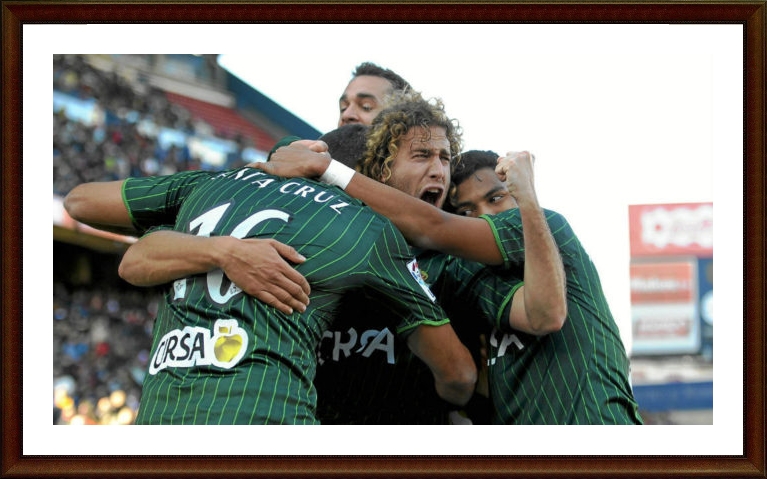
Following an internal split from Sevilla FC, another club was
formed, Betis Football Club. In 1914, they merged with Sevilla
Balompié. The club received its royal patronage in the same year,
and therefore adopted the name Real Betis Balompié. Fans continued
to refer to the club as Balompié and were themselves known as Los
Balompedistas until the 1930s, when Betis and the adjective
Béticos became common terminology when discussing the club and its
followers.
Real Betis wear a green and white Kit to honor their most famous
manager Paddy O'Connell, who was from Ireland. He led Betis to the
Segundo division in 1934 by a single point over Real Madrid.During
the Spanish Second Republic (1931–1939), royal patronage of all
organisations was nullified, and thus the club was known as Betis
Balompié until after the Spanish Civil War when it would revert to
the full name.
The club reached the Copa del Presidente de la República final
for the first time on 21 June 1931, when it lost 3–1 to Athletic
Bilbao in Madrid. Betis marked their 25th anniversary year by
winning their first Segunda División title in 1932, finishing two
points ahead of Oviedo FC, thus becoming the first club from
Andalusia to play in La Liga.Under the guidance of Irish coach
Patrick O'Connell on 28 April 1935 Betis won the La Liga, to date
their only top division title. They topped the table by a single
point over Madrid FC.
A year later Betis went down to seventh. This was due to the
dismantling of the championship-winning team because of the club's
poor economic situation and the arrival of the Civil War, meaning
that just 15 months after lifting the league title only two
players who won in 1935 were left: Peral and Saro. No official
league was held during the Civil War between 1936 and 1939, until
its resumption for the 1939–40 season and the first year back
highlighted Betis' decline as exactly five years after winning the
title the club was relegated.
Despite a brief return to the top division which lasted only one
season, the club continued to decline and in 1947 the worst fears
were reached when they were relegated to Tercera División. Many
fans see the ten years they spent in the category as key to the
"identity" and "soul" of the club. During this time, Betis earned
a reputation for filling its stadium and having a massive support
at away matches, known as the "Green March".
When the side returned to the second level in 1954, it gained the
distinction of being the only club in Spain to have won all three
major divisions' titles. Much of the credit for guiding Betis
through this dark period and back into the Segunda lies with
chairman Manuel Ruiz Rodríguez.In 1955, Manuel Ruiz Rodríguez
stepped down from running the club believing he could not offer
further economic growth, he was replaced by Betis most famous
former president, Benito Villamarín.
During his reign Betis returned to the top division in 1958–59
and finished in third place in 1964. His purchase of the Estadio
Heliópolis in 1961 is seen as a key point in the history of the
club – the grounds were called the Estadio Benito Villamarín until
1997. In 1965, Villamarín stepped down from his position after ten
years at the helm of the club.Just one year after Villamarín's
departure, the club would again be relegated to division two, then
rising and falling almost consecutively until consolidating their
place in the top level in 1974–75.
In its initial years, Sevilla Balompié dressed in blue shirts
with white shorts, which represented the infantry at the time.
From late 1911, the team had adopted the shirts of Celtic,at that
time vertical stripes of green and white, that were brought over
from Glasgow by Manuel Asensio Ramos, who had studied in Scotland
as a child. On 28 February, 2017, on the 37th Día de Andalucía,
Real Betis will wear Celtic-inspired hoops against Málaga CF.
When the team became Real Betis Balompié in 1914, various kits
were used, including: yellow and black stripes; green T-shirts and
a reversion to the blue top and white shorts uniform. By the end
of the 1920s, Betis was once again sporting green and white
stripes, around this time the Assembly of Ronda (1918) saw the
Andalusian region formally adopt these colours, not being known
how much the two are linked.Since then, this remained Betis'
shirt, despite several versions (including wider stripes).
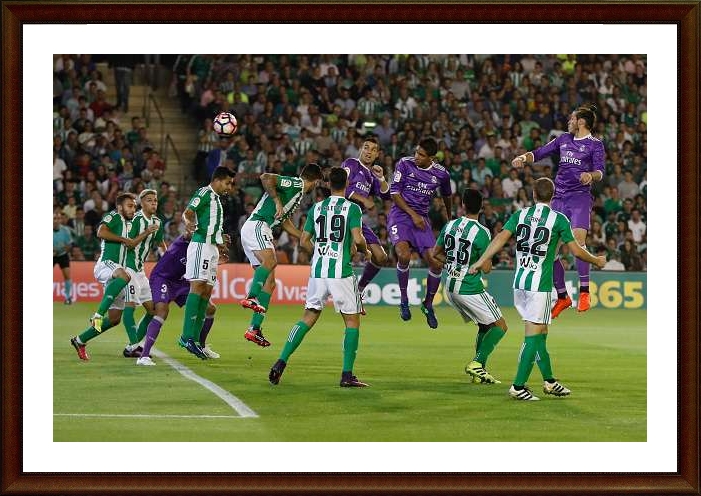
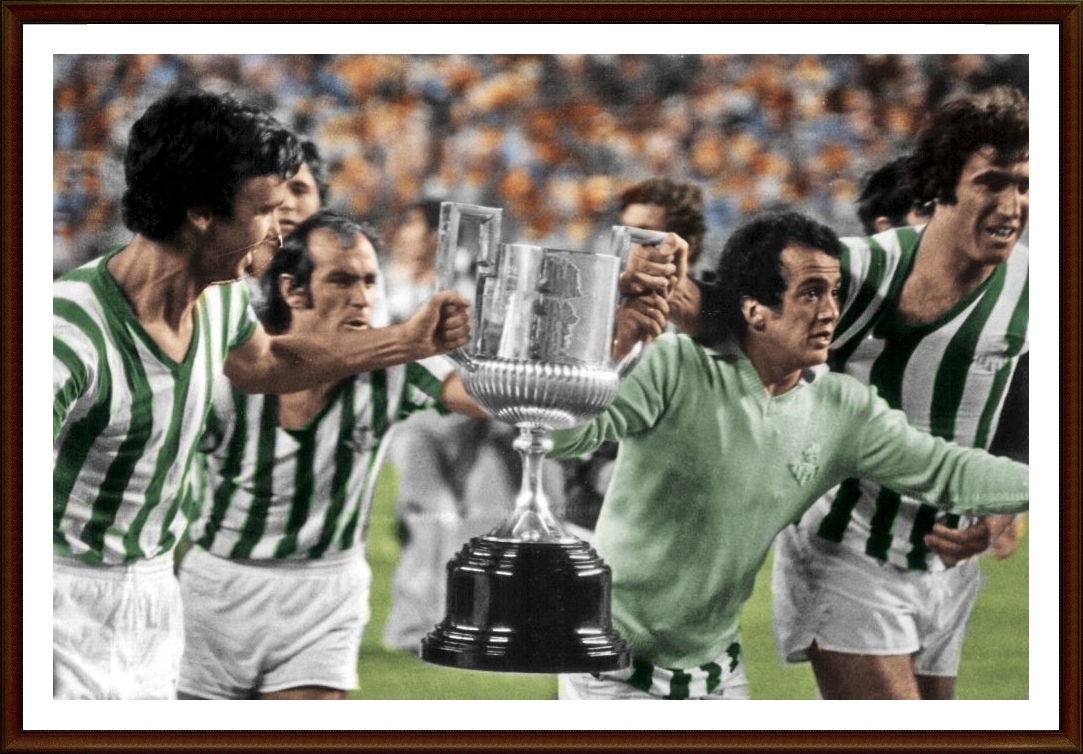
The following year, Betis returned to the top flight and ushered
in a period of "good times" for the club, with the next three
seasons seeing three top-six finishes, as well as UEFA Cup
qualification in 1982 and 1984. During the summer of 1982, the
Benito Villamarín hosted two matches as part of the 1982 FIFA
World Cup, and also witnessed
the Spain national team's famous 12–1 hammering of Malta in order
to qualify for UEFA Euro 1984.
In 1992, Betis found itself subject to new league rules and
regulations due to is restructuring as an autonomous sporting
group (SAD), requiring the club to come up with 1,200 million
pesetas, roughly double that of all the first and second division
teams, despite being in level two at the time.In just three
months, the fans raised 400 million
pesetas with then vice-president Manuel Ruiz de Lopera stepping in
to provide an economic guarantee while himself becoming majority
shareholder as the team narrowly avoided relegation.
After another three seasons in the second division, with the club
managed by Lorenzo Serra Ferrer, Betis returned to the top flight
for the 1994–95 season, subsequently achieving a final third
position, thus qualifying to the UEFA Cup. In the European
campaign, Betis knocked out Fenerbahçe (4–1 on aggregate) and 1.
FC Kaiserslautern (4–1)
before losing to defeated finalists Bordeaux (3–2). In 1997, 20
years after winning the trophy for the first time, the club
returned to the final of the Copa del Rey – again held in Madrid,
although this time at the Santiago Bernabéu Stadium – losing 2–3
against Barcelona after extra time.
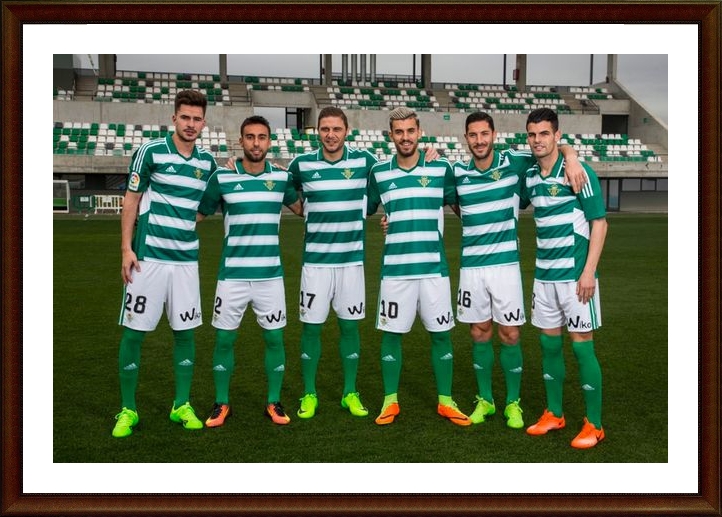
Incidentally, Barça was the club Serra Ferrer would leave Betis
for that summer, to be replaced by former player Luis Aragonés.
Aragonés would only last one season with the club, leading the
side to the eighth position and to the quarter-finals in the Cup
Winners' Cup, where they would lose 2–5 on aggregate to eventual
winners Chelsea. Aragonés was followed by the controversial reign
of Javier Clemente, who spat on a fan and implied Andalusia was
"another country!".
The team slipped down the table, finishing 11th and being knocked
out of the UEFA Cup by Bologna in the third round. For the next
couple of seasons, Betis went through numerous managers, a
relegation and a promotion, after which the team finished sixth in
the league with Juande Ramos at the helm.Ramos was gone after just
one season,
however, being replaced by former Cup Winners' Cup-winning manager
Víctor Fernández. He led the team to eighth and ninth in the
league and the third round of the 2002–03 UEFA Cup, being knocked
out by Auxerre (1–2 on aggregate), during his two-year reign.
For 2004, Fernández was replaced by the returning Serra Ferrer,
who guided the team to the fourth position in the top flight. They
also returned to the Vicente Calderón on 11 June 2005 for the Copa
del Rey final, lifting the trophy for only the second time after
an extra-time winner by youth graduate Dani in a 2–1 win against
Osasuna. The league finish meant Betis became the first Andalucian
team to compete in the UEFA Champions League, and it reached the
group stage after disposing of Monaco in the last qualifying round
(3–2 on aggregate).
Drawn in Group G, and in spite of a 1–0 home win against Chelsea, the club eventually finished third, being "demoted" to the UEFA Cup, where it would be ousted in the round of 16 by defeated Steaua București (0–0 away draw, 0–3 home loss).Betis celebrated their centenary year in 2007. The festivities included a special match against Milan, the reigning European Champions, on 9 August, with the hosts winning 1–0 thanks to a Mark González penalty early in the second half. Seven days later, the club won the Ramón de Carranza Trophy held in neighbouring Cádiz, beating Real Zaragoza on penalties in the final, having defeated Real Madrid in the semi-finals.
Surrounding the celebration, it was a time of great change in
terms of the playing and technical teams, with eight new signings
replacing 14 departures. During the two seasons (2006–07 and
2007–08) that encompassed the centenary year, Betis had four
different managers. During the latter campaign, the club was the
37th-best followed team in Europe regarding average
attendances.
After many years of staving off relegation, Betis' 2008–09
season culminated with a 1–1 draw against Real Valladolid at home.
With this outcome, the club finished 18th in the table and
consequently was relegated to the second division. On 15 June
2009, over 65,000 Beticos, including icons such as Rafael
Gordillo, Del Sol, Hipólito Rincón, Julio Cardeñosa and others,
joined the protest march in Sevilla with the slogan "15-J Yo Voy
Betis" to let the majority owner Ruiz de Lopera know that it was
time to put his 54% share of the club on the market for someone,
some entity or the Betis supporters to buy those shares and remove
Lopera from the day-to-day operations of the club.
Despite the protests, no upper management changes were made during
the season, which would ultimately see Betis fail to gain
promotion back to the top level.Seville judge Mercedes Alaya was
investigating links between Betis and other Ruiz de Lopera-owned
businesses, leading to him being formally charged with fraud. On 7
July 2010, one week before the start of preliminary court
proceedings, Lopera sold 94% of the shares that he owned (51% of
Betis total shares) to Bitton Sport, fronted by Luis Oliver, for
the surprisingly low figure of €16 million, leaving Lopera with
only minor shares; Oliver had already reportedly taken two
football clubs, Cartagena and Xerez, to the brink of bankruptcy.
Before the sale could be officially sanctioned, however, Ayala
froze Lopera shareholdings. Left with nothing, despite putting
down a €1 million deposit, Oliver hastily bought a nominal number
of shares from a third party and was voted onto the board of
directors by the existing members (all former cohorts of Lopera),
allowing him to carry on running the club. In response to this,
the judge appointed well-respected former Betis, Real Madrid and
Spain national team legend Rafael Gordillo to administrate
Lopera's shares to ensure Lopera was not still running the club
and that decisions made were for the benefit of the club not
individual board members.

Again under Pepe Mel, Betis started 2011–12 with four wins in as
many games, with Rubén Castro retaining his goal scoring
form from the previous season, where he scored 27 goals. Betis
finished 13th in their first season since returning to La Liga.In
the 2012–13 season, Betis finished seventh in La Liga and
qualified for the 2013–14 UEFA Europa League, the first European
qualification for the club since the 2005–06 Champions League.
This European campaign ended in the quarter-finals after losing on
penalties to local rivals Sevilla. Betis were relegated from La
Liga with three games still to play in the 2013–14 season, but
returned immediately as champions with two games to spare.
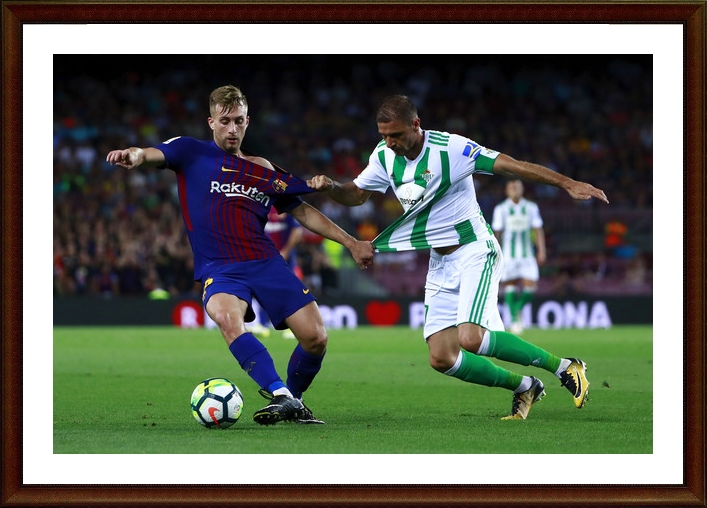
Betis have a long-standing rivalry with city neighbours Sevilla
FC.The two have met 114 times in official competition, with
Sevilla holding a 45% win ratio over Betis (31%). The first match
between the two clubs took place on 8 February 1915, with Sevilla
winning 4–3. The match was not completed, as high tensions led an
aggressive crowd to invade the pitch, forcing the referee to
abandon the match.In 1916, the first Copa Andalucía was held, this
being the first official derby of the Sevilla area. Of the 17
runnings of the cup, Sevilla were victorious 14 times, to Betis'
one sole conquest this included a 22–0 routing after the latter
sent their youth team, in 1918.
The first time the teams met in league, in Segunda, happened in
1928–29, with both teams winning their home matches (3–0 and 2–1).
They played for the first time in the Spanish top division during
the 1934–35 season, with a 0–3 home defeat for Sevilla and a 2–2
draw at Betis, with the latter winning the national
championship.On 17 January 1943, Betis lost 5–0 at Sevilla,
eventually being relegated. In the first game held at the Ramón
Sánchez Pizjuán Stadium, on 21 September 1958, the Verdiblancos
won it 4–2.
In later years, several matches were also marred by violence, including: a security guard attacked by a Sevilla fan with a crutch (that he did not require to walk), Betis goalkeeper Toni Prats being attacked and Sevilla manager Juande Ramos being struck by a bottle of water the latter incident led to the 2007 Copa del Rey match being suspended, being played out three weeks later in Getafe with no spectators.On 7 February 2009, Betis won 2–1 at the Pizjuán, but was eventually relegated from the top flight, while Sevilla finished in third position.
Read more about footballer profiles, history of famous football teams, also football prediction matches via Sbobet Mobile App